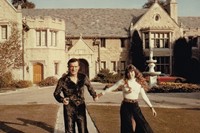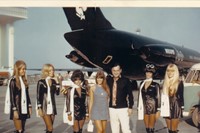A new book celebrates the bunny girl and the man who created her.
Everybody knows Playboy. No magazine has ever had a more famous logo. Nor has there ever been a more notorious editor-in-chief than the blonde enthusiast, silk pyjama-clad Hugh Hefner. However, there’s more to the saucy bunny than meets the eye, as proved by a new publication from Taschen, titled Hugh Hefner’s Playboy, a 6-volume anthology celebrating the decadence, sophistication and wit of the original men’s magazine and its creator – including never-before-seen personal photos, a behind-the-scenes look at the Playboy world and an autobiographical text by Hef himself.
Hugh Marston Hefner was only 27 when the first issue of his magazine (called “Playboy” only after alternative titles “Stag Party”, “Bachelor” and “Top Hat” were discarded) came out, famously featuring a redhead, naked Marilyn Monroe as its first-ever centrefold. He was a University of Illinois psychology graduate who had written for a military newspaper in the US Army during World War II. In 1953, he was working as a copywriter for Esquire, but after being denied a 5$ raise he left his job, mortgaged his furniture and obtained 8000$ from 45 investors (including his own mother) to start a new project. A risky business, but also a brilliant one: the first issue sold 50.000 copies. The rest is history.
"The first issue of Playboy sold 50.000 copies. The rest is history."
Playboy became promptly known for its enticing centrefolds, the girl-next-door charm of its Playmates and its worldly, sharp ideal of masculinity. But there was a subversive edge beyond the glamorous pictures and the man-about-town lessons. In 1955 Hefner became an ahead-of-his-time supporter of LGBT rights when he published Charles Beaumont’s The Crooked Man, a science fiction short story about straight men persecuted in a world were homosexuality was the norm. “If it is wrong to persecute heterosexuals in a homosexual society then the reverse is wrong, too”, he stated after receiving angry letters in response to the piece. The Crooked Man was only one of the many stories published during Playboy’s golden years: Ray Bradbury’s Fahrenheit 451 was first published there as a serialized story. Vladimir Nabokov, John Updike, Bernard Malamud, Margaret Atwood and Joyce Carol Oates also wrote for the magazine, and Martin Luther King, Malcolm X, Barbra Streisand, John Lennon and Yoko Ono, among others, were interviewed by its staff (which, incidentally, included several women in positions of power). During the 50s, 60s and 70s, Hef was an avid activist and supporter of the Civil Rights Movement, the pill, liberal drug laws and animal rights. Meanwhile, his clubs turned Playboy Enterprises Inc. into a booming financial success. Overloaded, Hef took to working at night from his round bed in the Playboy Mansion, wearing a silk pyjamas and a velvet robe. It was the beginning of his iconic look: “Eventually, pyjamas became something that represented the Playboy lifestyle, and people expected me to turn up at parties wearing them.” In 1975, his daughter Christie joined the editorial office and became head of the company in 1988. By then, the magazine was in decline. Countless imitations had risen, erotic and porn films were widely available and interest in the masculine press was quickly dropping. But Hef remained placid. After all, Playboy was already a legend.
Hugh Hefner’s Playboy is out now, published by Taschen.
Text by Marta Represa



